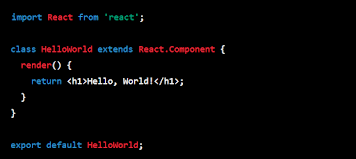REACT
What is React
React is a JavaScript library for building user interfaces.
It was developed and maintained by Facebook and is now open-sourced.
React allows developers to build reusable UI components and
manage the state of an application in a way that makes it easy to reason about,
test, and maintain. It uses a virtual DOM (Document Object Model) which
optimizes the update process by minimizing the number of changes made to the
actual DOM, improving the performance of the application.
React uses a declarative approach for building components
which makes it easy to understand and maintain the code. It also makes it easy
to integrate with other JavaScript libraries and frameworks, such as Redux for
state management.
React is particularly popular for building single-page
applications (SPAs) as well as progressive web apps (PWAs). React also has a
large and active community, which makes it easy to find help and resources when
working with it.
Example of React
Here's an example of a
simple React component that displays "Hello, World!" on a web page:
This component uses JSX, a syntax extension for JavaScript
that allows you to write HTML-like elements in your JavaScript code.
To use this component in a web page, you'll need to import
it and render it to the DOM using ReactDOM.render() method:
This code will render the “HelloWorld” component to an
element with the id of “root”.
This is a very simple example of react component, but it is
possible to create complex components with state and props, and handle events.
It's also possible to compose multiple components together to build an
application. This is just an example of how to react works, and you can find more
complex examples on web development and single-page applications.
Types of React
React is a JavaScript library for building user interfaces,
and as such, it can be used for a wide variety of applications. Here are a few
examples of different types of applications that can be built with React:
- Single-page Applications (SPAs): React is commonly used to build SPAs, which are web applications that load a single HTML page and dynamically update the content as the user interacts with the application. Reacts ability to manage and update the state of an application makes it well-suited for building SPAs.
- Progressive Web Applications (PWAs): React can be used to build PWAs, which are web applications that can be installed on a user's device and run offline. React's ability to render and update the UI in response to changes in the state makes it well-suited for building PWAs.
- Static Sites: React can also be used to build static sites, which are pre-built HTML pages that are served to users without any dynamic updates. React can be used to build the HTML pages in advance, and then the pre-built HTML pages can be served to users.
- Mobile Applications: React Native is a framework for building mobile applications for iOS and Android using React. It allows developers to use React to build mobile apps that have a similar look and feel to native apps.
- Desktop Applications: React can be used in conjunction with Electron to build cross-platform desktop applications. Electron allows developers to build desktop apps using web technologies such as JavaScript, HTML, and CSS.
- Virtual Reality Applications: React can be used to build virtual reality applications with libraries like React 360, React VR, and A-Frame. These libraries allow developers to build VR experiences using React components and JavaScript.
These are just a few examples of the many different types of
applications that can be built with React. As the React community is very
active, new libraries and tools are being developed all the time to support new
use cases and platforms.
Advantage of React
React is a popular JavaScript library for building user
interfaces, and there are many advantages to using it for web development. Here
are a few examples:
- Reusability: React allows developers to build reusable components, which can be easily composed to build more complex user interfaces. This can make it faster and easier to develop and maintain large web applications.
- Performance: React uses a virtual DOM (Document Object Model) which optimizes the update process by minimizing the number of changes made to the actual DOM, improving the performance of the application.
- Ease of Debugging: Reacts component-based architecture makes it easy to understand and debug the structure and behavior of an application.
- Easy to Learn: React has a relatively simple and intuitive API, which makes it easy to learn, especially for developers who already have experience with other JavaScript libraries or frameworks.
- Flexibility: React can be used to build a wide variety of applications, from simple user interfaces to complex single-page applications and progressive web apps.
- Popularity: React is one of the most popular JavaScript libraries for building user interfaces, with a large and active community that regularly contributes new features and improvements.
- Easy integration: React can be easily integrated with other JavaScript libraries and frameworks, such as Redux for state management, making it easy to build complex web applications.
- Support for server-side rendering: React can be rendered on the server side to improve the load time of the application and SEO.
React has many advantages over other JavaScript libraries,
and it's well-suited for building complex and high-performance web applications.
It has become a de-facto standard for web development and is widely used in the
industry.
Disadvantage of React
React is a powerful and widely used JavaScript library for
building user interfaces, but like any technology, it also has its own set of
disadvantages that can be important to consider, depending on the context and
the use case. Here are a few examples:
- Steep learning curve: React can be difficult to learn for developers who are new to it, especially when compared to other JavaScript libraries. The concept of the virtual DOM and JSX can be challenging to understand and it can take some time to be proficient with it.
- Over-reliance on third-party libraries: React is a relatively low-level library and it requires additional libraries and frameworks to provide more advanced features such as routing, state management, and form handling.
- JavaScript fatigue: React requires developers to know and use a lot of different technologies and libraries, such as webpack, babel, and JSX, which can be overwhelming for developers.
- Poor SEO: React is generally not SEO-friendly since search engines have difficulty reading JavaScript-heavy web pages, this can be an issue for certain types of websites.
- Limited built-in support: React provides a minimal set of features and leaves many decisions to the developer, which can lead to a lack of consistency and best practices across projects.
- Rendering performance: Reacts virtual DOM can slow down rendering performance if not used correctly.
- Not a framework: React is a library, not a framework. It only provides a view layer of the application and developers need to use additional libraries and frameworks to manage the state and other features.
It's important to keep in mind that these are general
considerations, and the suitability and impact of these disadvantages will
depend on the specific use case and context. React is widely used in the
industry and it has proven to be a powerful and versatile tool for building web
applications, but it may not be the best fit for every use case.
.png)



Comments
Post a Comment